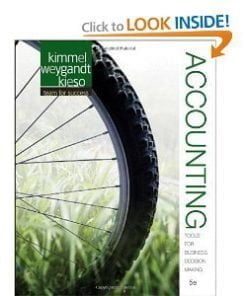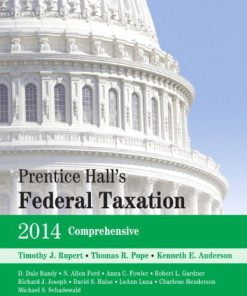Investments 11th Edition Bodie Solutions Manual
$35.00 Original price was: $35.00.$26.50Current price is: $26.50.
Investments 11th Edition Bodie Solutions Manual
Instant download Investments 11th Edition Bodie Solutions Manual pdf docx epub after payment.

Product details:
- ISBN-10 : 9781259277177
- ISBN-13 : 978-1259277177
- Author: Alan J. Marcus; Zvi Bodie
The integrated solutions for Bodie, Kane, and Marcus’ Investments set the standard for graduate/MBA investments textbooks. The unifying theme is that security markets are nearly efficient, meaning that most securities are priced appropriately given their risk and return attributes. The content places greater emphasis on asset allocation and offers a much broader and deeper treatment of futures, options, and other derivative security markets than most investment texts.Connect is the only integrated learning system that empowers students by continuously adapting to deliver precisely what they need, when they need it, and how they need it, so that your class time is more engaging and effective.
Table of contents:
- Part One: ELEMENTS OF INVESTMENTS
- Chapter 1 Investments: Background and Issues
- 1.1 Real Assets versus Financial Assets
- 1.2 Financial Assets
- 1.3 Financial Markets and the Economy
- The Informational Role of Financial Markets
- Consumption Timing
- Allocation of Risk
- Separation of Ownership and Management
- Corporate Governance and Corporate Ethics
- 1.4 The Investment Process
- 1.5 Markets Are Competitive
- The Risk-Return Trade-Off
- Efficient Markets
- 1.6 The Players
- Financial Intermediaries
- Investment Bankers
- Venture Capital and Private Equity
- 1.7 The Financial Crisis of 2008
- Antecedents of the Crisis
- Changes in Housing Finance
- Mortgage Derivatives
- Credit Default Swaps
- The Rise of Systemic Risk
- The Shoe Drops
- The Dodd-Frank Reform Act
- 1.8 Outline of the Text
- End-of-Chapter Material
- Chapter 2 Asset Classes and Financial Instruments
- 2.1 The Money Market
- Treasury Bills
- Certificates of Deposit
- Commercial Paper
- Bankers’ Acceptances
- Eurodollars
- Repos and Reverses
- Brokers’ Calls
- Federal Funds
- The LIBOR Market
- Yields on Money Market Instruments
- 2.2 The Bond Market
- Treasury Notes and Bonds
- Inflation-Protected Treasury Bonds
- Federal Agency Debt
- International Bonds
- Municipal Bonds
- Corporate Bonds
- Mortgage and Asset-Backed Securities
- 2.3 Equity Securities
- Common Stock as Ownership Shares
- Characteristics of Common Stock
- Stock Market Listings
- Preferred Stock
- Depositary Receipts
- 2.4 Stock and Bond Market Indexes
- Stock Market Indexes
- The Dow Jones Industrial Average
- The Standard & Poor’s 500 Index
- Other U.S. Market Value Indexes
- Equally Weighted Indexes
- Foreign and International Stock Market Indexes
- Bond Market Indicators
- 2.5 Derivative Markets
- Options
- Futures Contracts
- End-of-Chapter Material
- Chapter 3 Securities Markets
- 3.1 How Firms Issue Securities
- Privately Held Firms
- Publicly Traded Companies
- Shelf Registration
- Initial Public Offerings
- 3.2 How Securities are Traded
- Types of Markets
- Types of Orders
- Trading Mechanisms
- 3.3 The Rise of Electronic Trading
- 3.4 U.S. Markets
- NASDAQ
- The New York Stock Exchange
- ECNs
- 3.5 New Trading Strategies
- Algorithmic Trading
- High-Frequency Trading
- Dark Pools
- Bond Trading
- 3.6 Globalization of Stock Markets
- 3.7 Trading Costs
- 3.8 Buying on Margin
- 3.9 Short Sales
- 3.10 Regulation of Securities Markets
- Self-Regulation
- The Sarbanes-Oxley Act
- Insider Trading
- End-of-Chapter Material
- Chapter 4 Mutual Funds and Other Investment Companies
- 4.1 Investment Companies
- 4.2 Types of Investment Companies
- Unit Investment Trusts
- Managed Investment Companies
- Other Investment Organizations
- 4.3 Mutual Funds
- Investment Policies
- How Funds Are Sold
- 4.4 Costs of Investing in Mutual Funds
- Fee Structure
- Fees and Mutual Fund Returns
- 4.5 Taxation of Mutual Fund Income
- 4.6 Exchange-Traded Funds
- 4.7 Mutual Fund Investment Performance: A First Look
- 4.8 Information on Mutual Funds
- End-of-Chapter Material
- Part TWO: PORTFOLIO THEORY
- Chapter 5 Risk, Return, and the Historical Record
- 5.1 Rates of Return
- Measuring Investment Returns over Multiple Periods
- Conventions for Annualizing Rates of Return
- 5.2 Inflation and the Real Rate of Interest
- The Equilibrium Nominal Rate of Interest
- 5.3 Risk and Risk Premiums
- Scenario Analysis and Probability Distributions
- The Normal Distribution
- Normality and the Investment Horizon
- Deviation from Normality and Tail Risk
- Risk Premiums and Risk Aversion
- The Sharpe Ratio
- 5.4 The Historical Record
- Using Time Series of Returns
- Risk and Return: A First Look
- 5.5 Asset Allocation across Risky and Risk-Free Portfolios
- The Risk-Free Asset
- Portfolio Expected Return and Risk
- The Capital Allocation Line
- Risk Aversion and Capital Allocation
- 5.6 Passive Strategies and the Capital Market Line
- Historical Evidence on the Capital Market Line
- Costs and Benefits of Passive Investing
- End-of-Chapter Material
- Chapter 6 Efficient Diversification
- 6.1 Diversification and Portfolio Risk
- 6.2 Asset Allocation with Two Risky Assets
- Covariance and Correlation
- Using Historical Data
- The Three Rules of Two-Risky-Asset Portfolios
- The Risk-Return Trade-Off with Two-Risky-Assets Portfolios
- The Mean-Variance Criterion
- 6.3 The Optimal Risky Portfolio with a Risk-Free Asset
- 6.4 Efficient Diversification with Many Risky Assets
- The Efficient Frontier of Risky Assets
- Choosing the Optimal Risky Portfolio
- The Preferred Complete Portfolio and a Separation Property
- Constructing the Optimal Risky Portfolio: An Illustration
- 6.5 A Single-Index Stock Market
- Statistical Interpretation of the Single-Index Model
- Learning from the Index Model
- Using Security Analysis with the Index Model
- 6.6 Risk Pooling, Risk Sharing, and Time Diversification
- Time Diversification
- End-of-Chapter Material
- Chapter 7 Capital Asset Pricing and Arbitrage Pricing Theory
- 7.1 The Capital Asset Pricing Model
- The Model: Assumptions and Implications
- Why All Investors Would Hold the Market Portfolio
- The Passive Strategy Is Efficient
- The Risk Premium of the Market Portfolio
- Expected Returns on Individual Securities
- The Security Market Line
- Applications of the CAPM
- 7.2 The CAPM and Index Models
- 7.3 How Well Does the CAPM Predict Risk Premiums?
- 7.4 Multifactor Models and the CAPM
- The Fama-French Three-Factor Model
- Estimating a Three-Factor SML
- Multifactor Models and the Validity of the CAPM
- 7.5 Arbitrage Pricing Theory
- Diversification in a Single-Index Security Market
- Well-Diversified Portfolios
- The Security Market Line of the APT
- Individual Assets and the APT
People also search:
Investments 11th Edition
Investments 11th Edition pdf
Investments
investment about definition
investment about idea
Related products
Solution Manual
Solution manual for Accounting: Tools for Business Decision Making Kimmel Weygandt Kieso 5th Edition
Solution Manual
Solution Manual for Absolute C++, 5/E 5th Edition Walter Savitch
Solution Manual
International Accounting Doupnik 4th Edition Solutions Manual
Solution Manual
Solution Manual
Solution Manual
Prentice Hall’s Federal Taxation 2014 Comprehensive Rupert 27th Edition Solutions Manual











